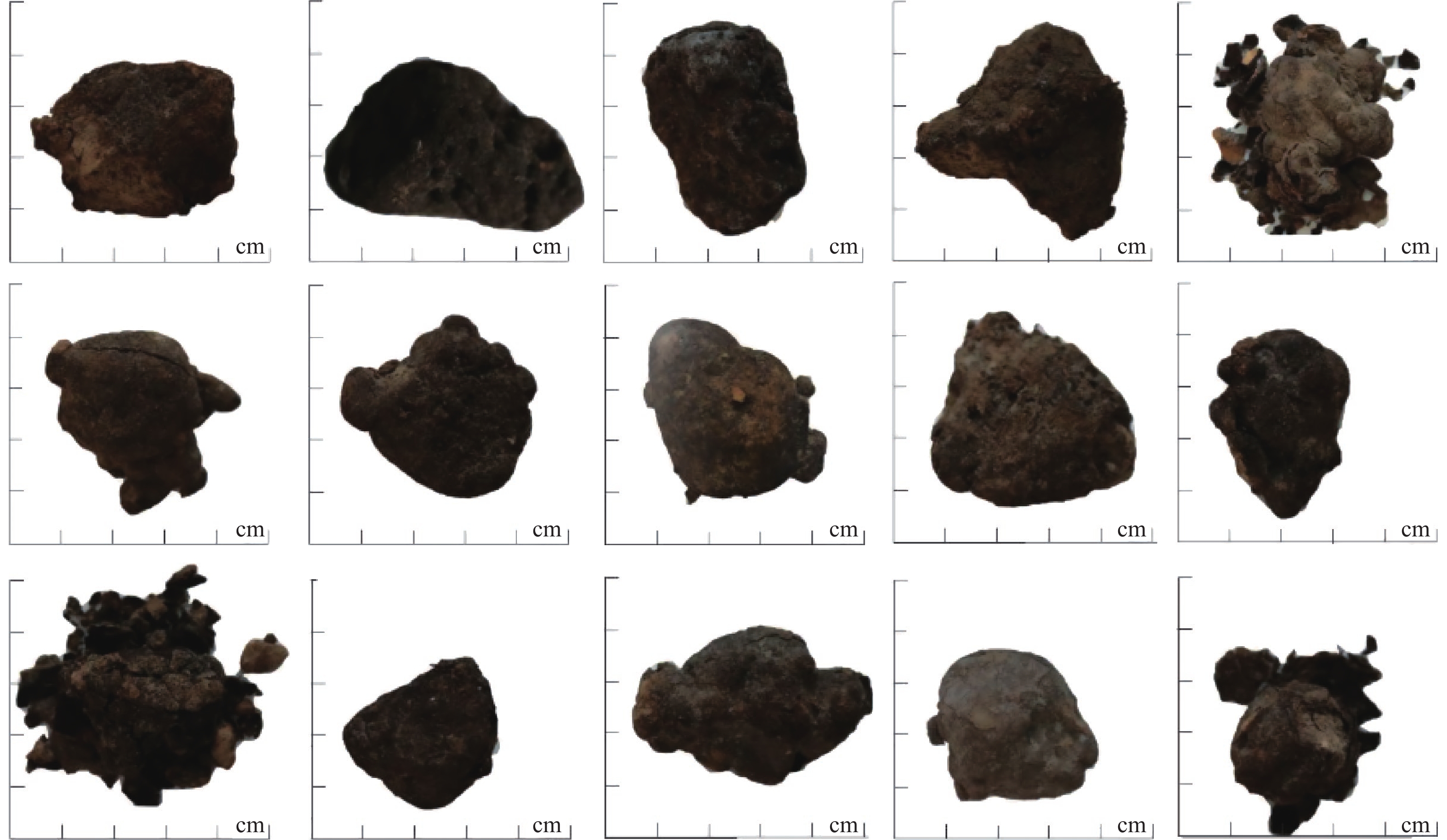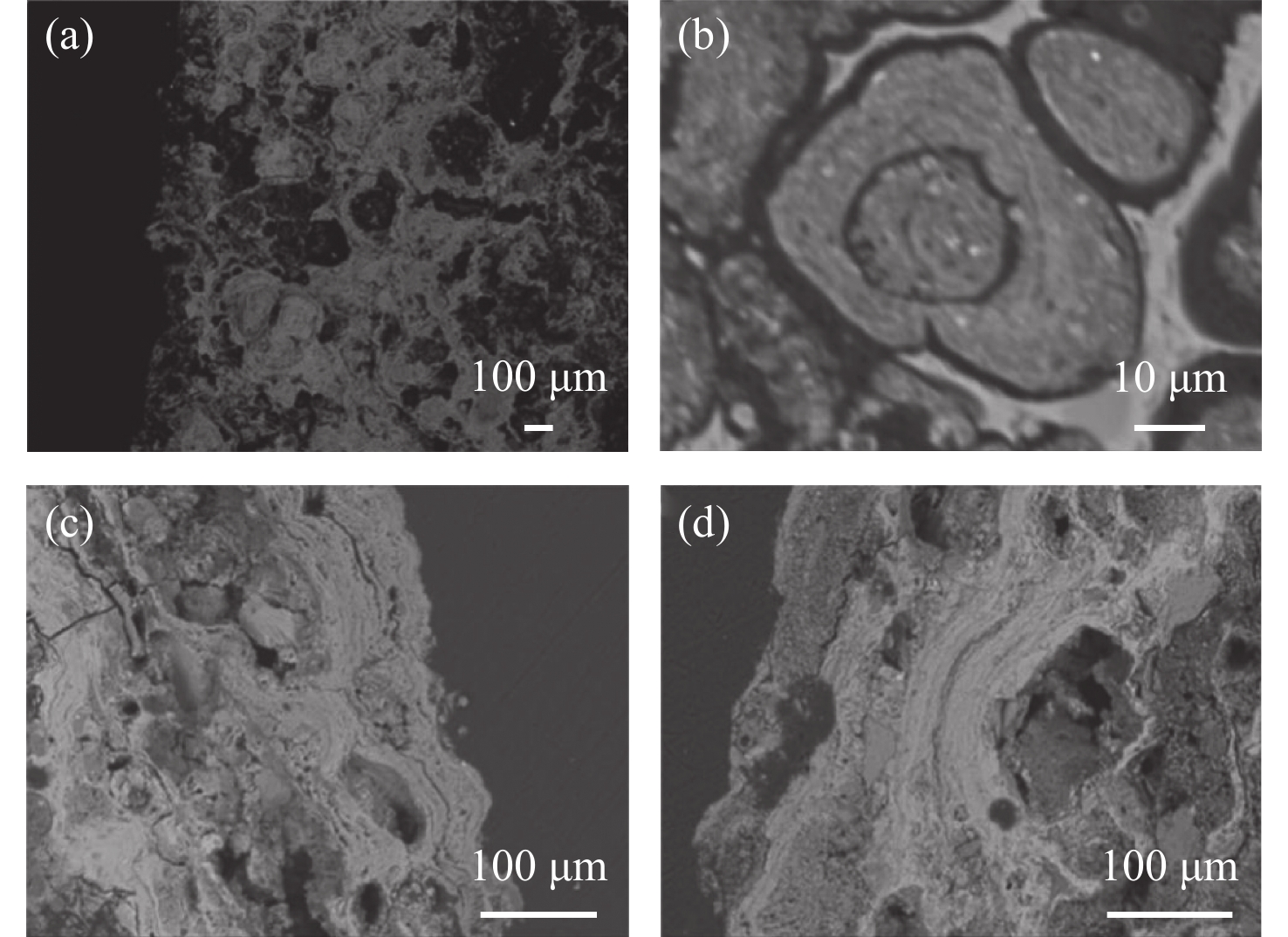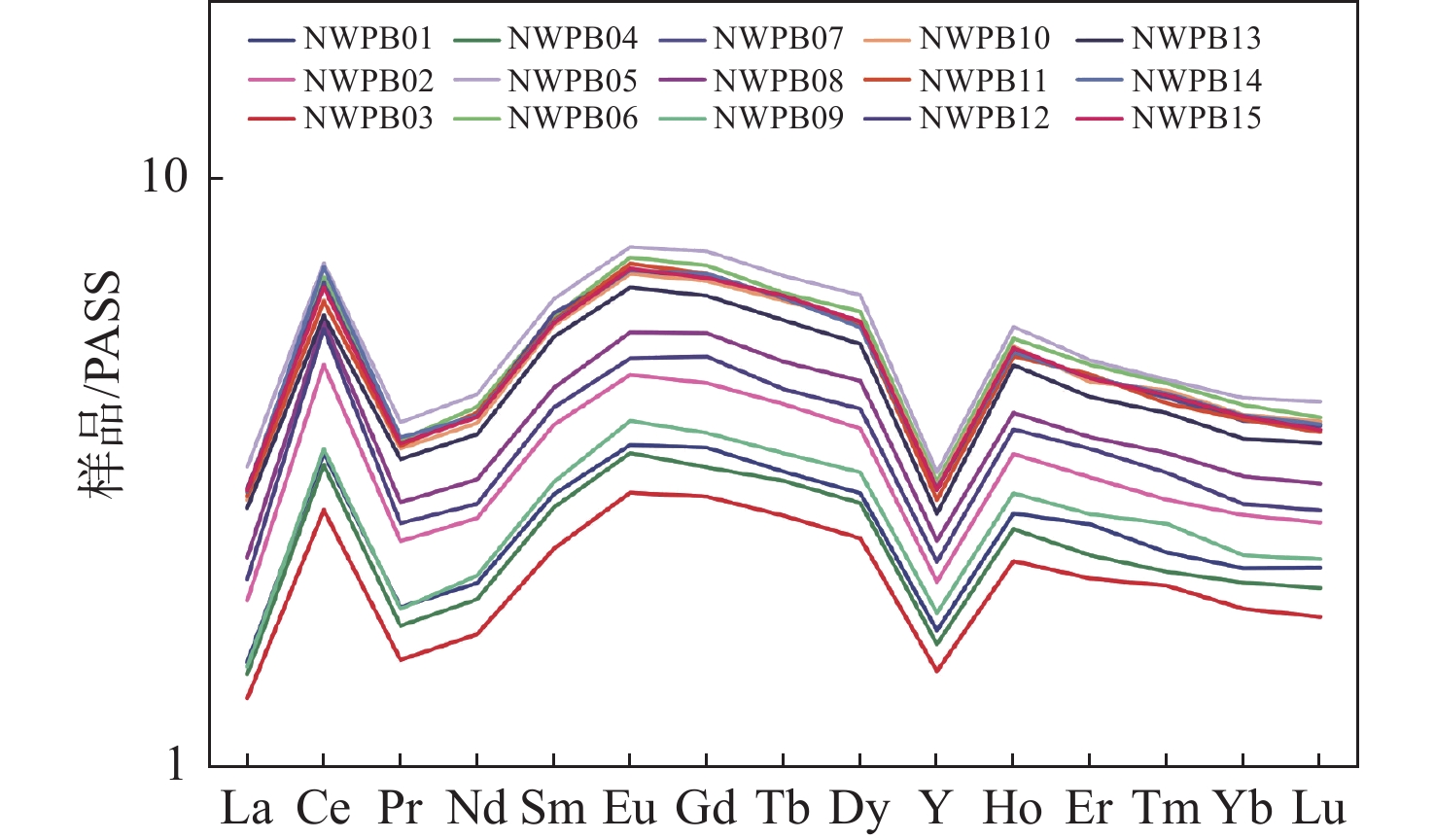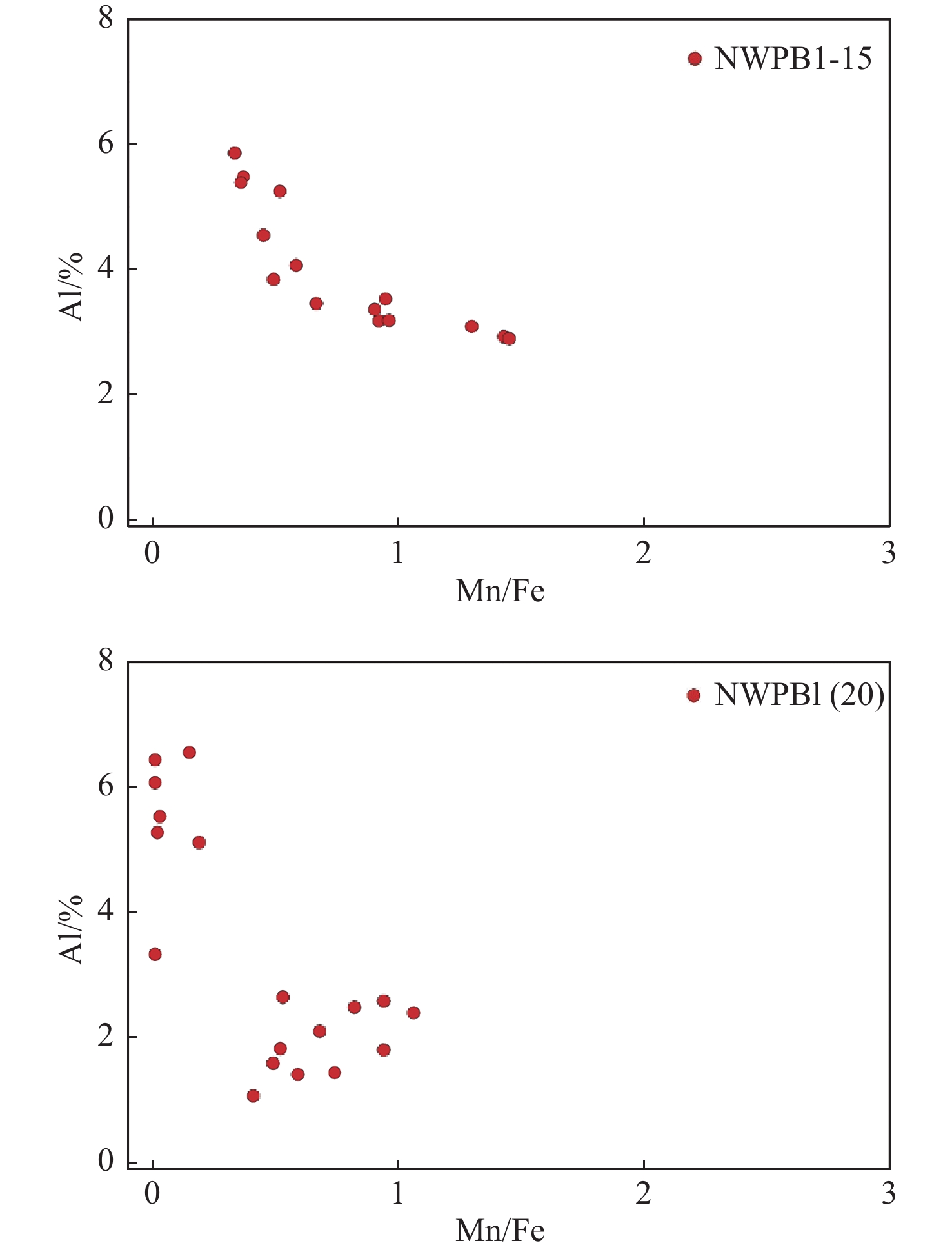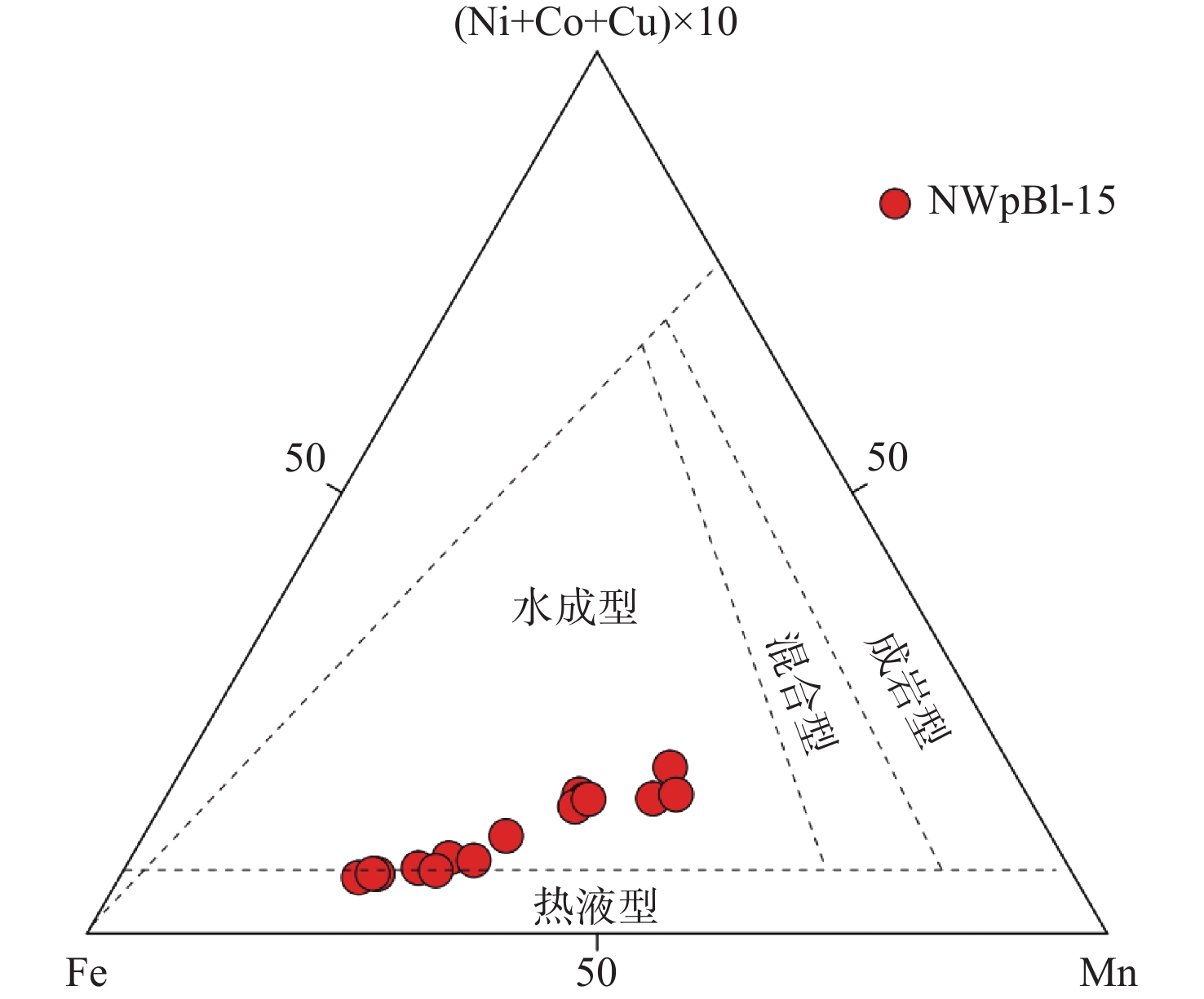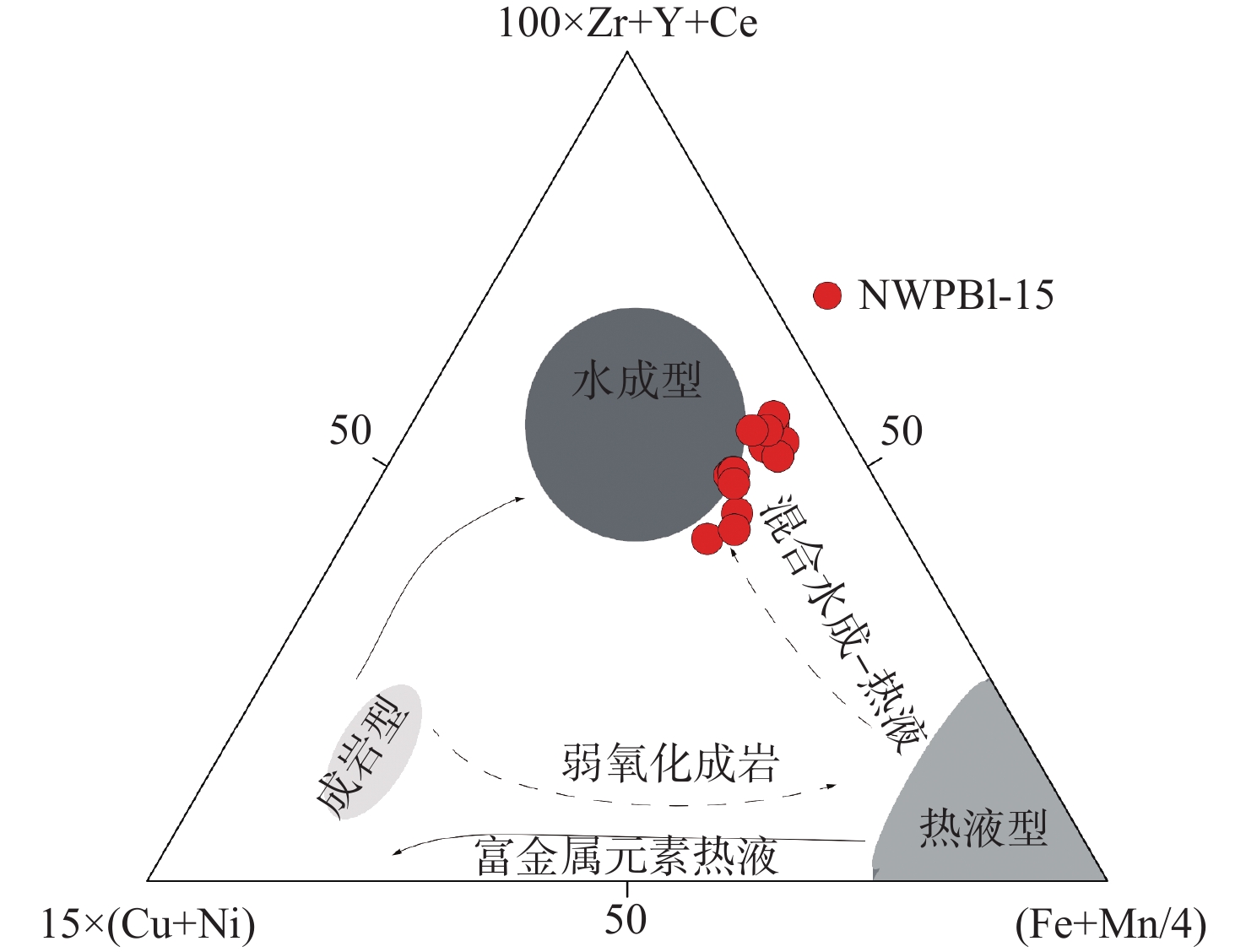Geochemical constraints on the formation mechanisms of manganese nodules from Cipangu Basin
-
摘要:
通过对西盘古海盆(Cipangu Basin)15个锰结核样品开展系统的形态结构、显微构造、矿物组成、常微量元素和稀土元素含量特征差异性研究,进而探讨该区锰结核的成因类型和生长机制。西盘古海盆锰结核外观为椭球状或连生体状,表面光滑,组成矿物主要有水羟锰矿、石英、钙长石和石盐;其稀土元素配分模式图表现出明显的Ce正异常、Y负异常和轻稀土富集特征。样品Mn/Fe比值均<2.5,与Ni、Cu正相关,且Mn与Cu、Co和Ni高度正相关,这表明因Cu2+、Ni2+、Co2+更易占据层板结构锰氧八面体MnO6的空位而在锰矿物表面富集。锰结核显微构造区域可划分为Type-Ⅰ型和Type-Ⅱ型,其中Type-Ⅰ型为结构致密高反射率的层纹状、柱状、叠层状构造的显微构造区域,Type-Ⅱ型为结构疏松低反射率的掌状、混杂状、环状构造的显微构造区域;Type-Ⅰ型区域的Mn/Fe比值和Ni、Ni + Cu、Co含量均高于Type-Ⅱ型区域。构造致密的Type-Ⅰ型区域代表沉积环境变化较小,生长速率较小;构造疏松的Type-Ⅱ型区域代表沉积环境剧烈变化、结核生长速率较大。西盘古海盆锰结核具有典型的水成型成因特征,通过常微量元素测试数据估算得出西盘古海盆锰结核样品的形成时间为1.48 Ma。据微区分析数据估算得出其生长年龄为2.44 Ma。
Abstract:In this study, a total of 15 manganese nodule samples were collected from Cipangu Basin in North Pacific Ocean. The morphological structure, microscopic structure, mineral composition, contents of trace elements and rare earth elements, and the differences among samples from different regions were studied systematically. The genetic types and growth mechanism of the manganese nodules were discussed. The manganese nodules are elliptic and intergrowth body with smooth surface. The major minerals are vernadite, quartz, albite, and halite. The REE distribution pattern shows obvious positive Ce anomaly, negative Y anomaly, and LREE enrichment characteristics. The Mn/Fe ratios of the samples from three sites of the study areas are all less than 2.5, which are positively correlated with Ni and Cu; and Mn is highly positively correlated with Cu, Co, and Ni, indicating that Cu, Ni, and Co are more likely to occupy the δ-MnO2 enrichment at the surface of manganese minerals. The microlayers of manganese nodules can be divided into two types, Type Ⅰ and Type Ⅱ. Type Ⅰ is laminated, columnar and laminated with dense and high reflectance structure, and Type Ⅱ is hybrid and ring with loose and low reflectance structure. The Mn/Fe, Ni, Ni + Cu, and Co in Type Ⅰ were greater than those of Type Ⅱ. The Type Ⅰ area has loose manganese nodule in structure reflecting great changes in sedimentary environment with great growth rate of nodule, while the Type Ⅱ zone has small changes in sedimentary environment with small growth rate. The manganese nodule samples are formed by metal precipitation from the ambient seawater (hydrogenetic) and the age was estimated to be 1.48 Ma based on the ordinary trace element test data. At last, according to the micro-analysis data, the growth age was 2.44 Ma by estimation.
-
Key words:
- manganese nodules /
- Cipangu Basin /
- genetic types /
- formation mechanism
-

-
图 9 Fe-Mn-(Co+Ni+Cu)×10三角图[20]
Figure 9.
图 10 15×(Cu+Ni)-100×(Zr+Y+Ce)-(Fe + Mn)/4三角图[3]
Figure 10.
图 11 CeSN/CeSN*与YSN/HoSN和Nd比值图[17]
Figure 11.
表 1 西盘古海盆锰结核壳体常量元素和金属元素含量
Table 1. Macro element and metal element contents of manganese nodule from the Cipangu Basin
% Fe Mn Al2O3 CaO K2O MgO Na2O P2O5 TiO2 Ba Sr Co Ni Cu Mn/Fe 最小值 8.72 3.99 5.49 2.24 0.98 1.92 3.33 0.34 0.54 0.05 0.04 0.02 0.04 0.05 0.33 最大值 16.46 19.5 11.08 3.04 1.8 2.71 6.64 0.6 0.86 0.12 0.07 0.06 0.43 0.28 1.45 平均值 13.81 10.97 7.58 2.46 1.24 2.26 4.43 0.49 0.77 0.08 0.06 0.04 0.19 0.13 0.78 表 2 西盘古海盆锰结核壳体微量元素含量
Table 2. Trace element content in the shell of manganese nodule from the Cipangu Basin
mg/kg Cr V Zn Zr Sc Rb Nb Mo 最小值 15.01 192.68 208.22 197.1 11.9 21.09 11.37 27.89 最大值 35.43 428.18 744.25 396.2 19.29 57.02 22.58 309.01 平均值 23.18 330.32 430.47 311.64 14.1 31.48 17.6 141.05 Cd Cs Hf W Tl Pb Th U 最小值 0.98 1.73 5.11 6.19 9.99 248.4 23.76 2.46 最大值 8.57 4.71 8.14 21.04 46.77 687.7 51.72 5.16 平均值 3.91 2.59 6.83 11.08 25.66 519.27 40.9 3.77 表 3 西盘古海盆锰结核稀土元素组成
Table 3. Rare earth elements of manganese nodules in the Cipangu Basin
mg/kg La Ce Pr Nd Sm Eu Gd Tb Dy Ho 最小值 90.48 431.84 25.5 108.58 25.7 6.14 25.83 3.9 21.7 4.14 最大值 50.03 217.4 13.43 57.01 13.03 3.16 13.43 2.06 11.45 2.22 平均值 123.5 570.4 34.02 145.7 34.62 8.26 35.02 5.26 29.64 5.54 Er Tm Yb Lu Y ΣREY ΣCe/ΣY δCe δEu Y/Ho 最小值 10.78 1.45 9.13 1.35 66.57 833.09 6.42 2.07 1.12 16.27 最大值 5.96 0.83 5.24 0.77 39.28 435.31 5.53 1.92 1.09 15.26 平均值 14 1.87 11.95 1.8 85.5 1107.07 7.33 2.37 1.15 17.73 表 4 西盘古海盆锰结核元素相关系数矩阵
Table 4. The Pearson correlation coefficient matrix for major and valuable metal elements of manganese nodule shell from the Cipangu Basin
TFe TMn Al2O3 CaO MgO K2O Na2O Ti2 P2O5 Ba Co Cu Ni Sr REY TFe 1 TMn 0.499 1 Al2O3 −0.687 -0.919 1 CaO −0.2 −0.475 0.531 1 MgO −0.421 −0.633 0.763 0.542 1 K2O −0.822 −0.853 0.958 0.343 0.686 1 Na2O −0.727 −0.868 0.81 0.292 0.556 0.848 1 Ti2 O 0.864 0.335 −0.397 0.016 −0.081 −0.583 −0.646 1 P2O5 0.957 0.553 −0.771 −0.232 −0.601 −0.888 −0.715 0.738 1 Ba 0.555 0.978 −0.91 −0.463 −0.692 −0.856 −0.91 0.395 0.61 1 Co 0.779 0.899 −0.954 −0.491 −0.734 −0.954 −0.893 0.577 0.834 0.932 1 Cu 0.444 0.977 −0.858 −0.404 −0.567 −0.791 −0.856 0.322 0.49 0.974 0.869 1 Ni 0.48 0.977 −0.873 −0.451 −0.609 −0.807 −0.866 0.357 0.531 0.982 0.898 0.993 1 Sr 0.815 0.875 −0.962 −0.425 −0.72 −0.979 −0.87 0.593 0.87 0.902 0.982 0.828 0.852 1 REY 0.862 0.825 −0.937 −0.463 −0.729 −0.964 −0.862 0.651 0.908 0.864 0.982 0.774 0.811 0.988 1 表 5 常量分析生长速率计算
Table 5. Calculations of growth rate from constant analysis
编号 NWPB1 NWPB2 NWPB3 NWPB4 NWPB5 NWPB6 NWPB7 NWPB8 NWPB9 R/(mm/Ma) 0.93 0.98 1.4 0.9 1.36 1.46 1.39 0.98 0.89 编号 NWPB10 NWPB11 NWPB12 NWPB13 NWPB14 NWPB15 最小值 最大值 平均值 R/(mm/Ma) 1.94 2.12 1.12 2.17 1.1 1.46 0.89 2.17 1.35 表 6 基于全岩常量元素含量的生长年龄计算
Table 6. Calculations of growth age based on major elements of whole rocks
R/(mm/Ma) 厚度/mm 年龄/Ma 西盘古海盆 最小值 0.89 2.00 2.25 最大值 2.17 2.00 0.92 平均值 1.35 2.00 1.48 表 7 基于EPMA分析数据的生长速率计算
Table 7. Calculations of growth rate based on EPMA data
样品区域 结构类型 Fe/% Mn/% R/(mm/Ma) 西盘古海盆 总平均 最小值 4.56 0.06 0.46 最大值 28.04 21.29 1.29 平均值 15.22 8.7 0.82 Type-Ⅰ型 最小值 18.75 10.5 0.7 最大值 26.15 21.29 1.29 平均值 22.03 16.22 1.02 Type-Ⅱ型 最小值 4.56 0.06 0.46 最大值 28.04 17.52 1.13 平均值 10.67 3.69 0.69 -
[1] HELLER C,KUHN T,VERSTEEGH G M,et al. The geochemical behavior of metals during early diagenetic alteration of buried manganese nodules[J]. Deep Sea Research Part I Oceanographic Research Papers,2018,142:16-33. doi: 10.1016/j.dsr.2018.09.008
[2] BAU M,KOSCHINSKY A,DULSKI P,et al. Comparison of the partitioning behaviours of yttrium,rare-earth elements,and titanium between hydrogenetic marine ferromanganese crusts and seawater[J]. Geochimica et Cosmochimica Acta,1996,60(10):1709-1725. doi: 10.1016/0016-7037(96)00063-4
[3] JOSSO P,PELLETER E,POURRET O,et al. A new discrimination scheme for oceanic ferromanganese deposits using high field strength and rare earth elements[J]. Ore Geology Reviews,2017,87:3-15. doi: 10.1016/j.oregeorev.2016.09.003
[4] KUHN T,BAU M,BLUM N,et al. Origin of negative Ce anomalies in mixed hydrothermal-hydrogenetic Fe-Mn crusts from the Central Indian Ridge[J]. Earth and Planetary Science Letters,1998,163(1/4):207-220.
[5] QUINN K A,BYRNE R H,SCHIJF J. Comparative savenging of Yttrium and the rare earth elements in seawater:competitive influences of solution and surface chemistry[J]. Aquatic Geochemistry,2004,10(1/2):59-80. doi: 10.1023/B:AQUA.0000038959.03886.60
[6] WEGORZEWSKI A V,KUHN T. The influence of suboxic diagenesis on the formation of manganese nodules in the Clarion Clipperton nodule belt of the Pacific Ocean[J]. Marine Geology,2014,357:123-138. doi: 10.1016/j.margeo.2014.07.004
[7] PAUL S,HAECKEL M,BAU M,et al. Small-scale heterogeneity of trace metals including rare earth elements and yttrium in deep-sea sediments and porewaters of the Peru Basin,southeastern equatorial Pacific[J]. Biogeosciences,2019,16(24):4829-4849. doi: 10.5194/bg-16-4829-2019
[8] GONZÁLEZ F J,SOMOZA L,HEIN J R,et al. Phosphorites,Co-rich Mn nodules,and Fe‐Mn crusts from Galicia Bank,NE Atlantic:reflections of Cenozoic tectonics and paleoceano-graphy[J]. Geochemistry,Geophysics,Geosystems,2016,17(2):346-374.
[9] LI Z,LI H,HEIN J R,et al. A possible link between seamount sector collapse and manganese nodule occurrence in the abyssal plains,NW Pacific Ocean[J]. Ore Geology Reviews,2021,138:104378. doi: 10.1016/j.oregeorev.2021.104378
[10] Nozaki Y. A fresh look at element distribution in the North Pacific Ocean[J]. EOS Transactions,1997,78:221-223.
[11] DENG X, HE G, XU Y, et al. Oxic bottom water dominates polymetallic nodule formation around the Caiwei Guyot, northwestern Pacific Ocean[J]. Ore Geology Reviews, 2022: 104776.
[12] BOLLHOFER A,FRANK N,ROHLOFF S,et al. A record of changing redox conditions in the northern Peru Basin during the Late Quaternary deduced from Mn/Fe and growth rate variations in two diagenetic manganese nodules[J]. Earth and Planetary Science Letters,1999,170(4):403-415.
[13] HALBACH P, FRIEDRICH G, STACKELBERG U V. The manganese nodule belt of the Pacific Ocean : geological environment, nodule formation, and mining aspects[M]. Stuttgart: Ferdinand Enke, 1988.
[14] HEIN J R,KOSCHINSKY A,HALBACH P,et al. Iron and manganese oxide mineralization in the Pacific[J]. Geological Society London Special Publications,1997,119(1):123-138. doi: 10.1144/GSL.SP.1997.119.01.09
[15] MCSWIGGEN P. Manganese mineralization:geochemistry and mineralogy of terrestrial and marine deposits[J]. Mineralogical Magazine,1997,61(409):907-907.
[16] KOSCHINSKY A,HALBACH P. Sequential leaching of marine ferromanganese precipitates:genetic implications[J]. Geochimica et Cosmochimica Acta,1995,59(24):5113-5132. doi: 10.1016/0016-7037(95)00358-4
[17] BAU M,SCHMIDT K,KOSCHINSKY A,et al. Discriminating between different genetic types of marine ferro-manganese crusts and nodules based on rare earth elements and Yttrium[J]. Chemical Geology,2014,381:1-9. doi: 10.1016/j.chemgeo.2014.05.004
[18] 黄威,胡邦琦,徐磊,等. 帕里西维拉海盆西缘中段铁锰结核的地球化学特征和成因类型[J]. 海洋地质与第四纪地质,2021,41(1):199-209. doi: 10.16562/j.cnki.0256-1492.2020101501
[19] 李彦杰,董明明. 海底铁锰矿物中稀土元素富集的控制因素[J]. 科技资讯,2019,17(12):76-80. doi: 10.16661/j.cnki.1672-3791.2019.12.076
[20] HALBACH P,SCHERHAG C,HEBISCH U,et al. Geochemical and mineralogical control of different genetic types of deep-sea nodules from the Pacific Ocean[J]. Mineralium Deposita,1981,16(1):59-84.
[21] MANCEAU A,LANSON M,TAKAHASHI Y. Mineralogy and crystal chemistry of Mn,Fe,Co,Ni,and Cu in a deep-sea Pacific polymetallic nodule[J]. American Mineralogist,2014,99(10):2068-2083. doi: 10.2138/am-2014-4742
[22] HEIN J R,CONRAD T,MIZELL K,et al. Controls on ferromanganese crust composition and reconnaissance resource potential,Ninetyeast Ridge,Indian Ocean[J]. Deep Sea Research Part I:Oceanographic Research Papers,2016,110:1-19. doi: 10.1016/j.dsr.2015.11.006
[23] PELLETER E,FOUQUET Y,ETOUBLEAU J,et al. Ni-Cu-Co-rich hydrothermal manganese mineralization in the Wallis and Futuna back-arc environment (SW Pacific)[J]. Ore Geology Reviews,2017,87:126-146. doi: 10.1016/j.oregeorev.2016.09.014
[24] SCHMIDT K,BAU M,HEIN J R,et al. Fractionation of the geochemical twins Zr–Hf and Nb–Ta during scavenging from seawater by hydrogenetic ferromanganese crusts[J]. Geochimica et Cosmochimica Acta,2014,140:468-487. doi: 10.1016/j.gca.2014.05.036
[25] LYLE M. Estimating growth rates of ferromanganese nodules from chemical compositions:implications for nodule formation processes[J]. Geochimica et Cosmochimica Acta,1982,46(11):2301-2306. doi: 10.1016/0016-7037(82)90203-4
-



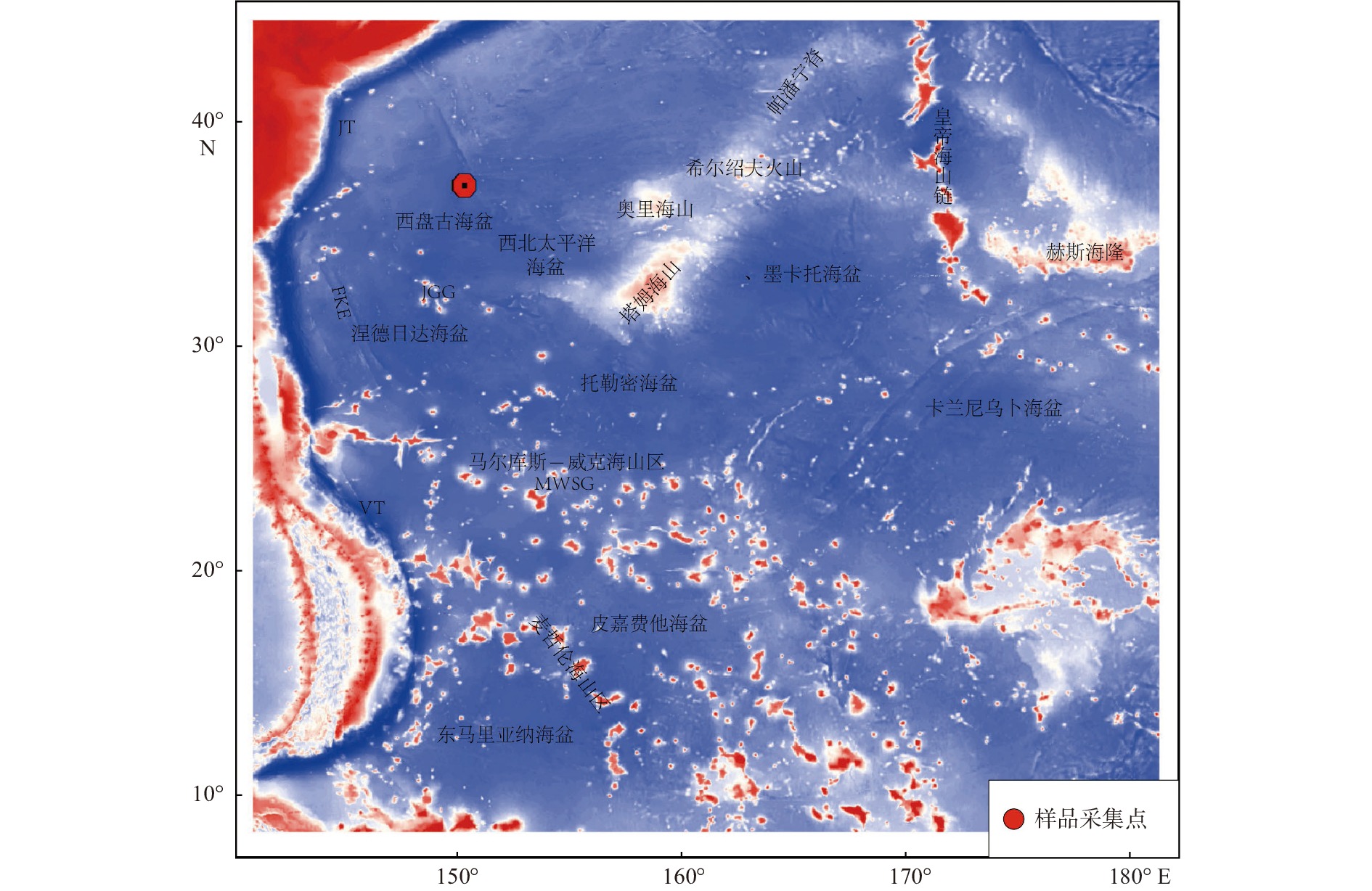
 下载:
下载:
